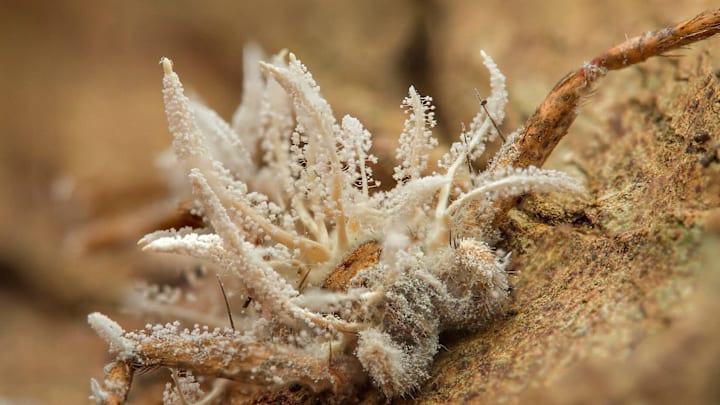Shooting great documentary footage requires some luck, and a BBC nature series hit the jackpot while filming in Northern Ireland in 2021. As Popular Science reports, a team of scientists working on Winterwatch discovered a new type of fungus that zombifies its spider hosts. Subsequent research on the parasitic dynamic has been published in the journal Fungal Systematics and Evolution.
The first infected spider was discovered on the ceiling of an abandoned gunpowder storage room during the documentary shoot. Upon realizing they didn’t recognize the fungus, the BBC team sent a photo of the unidentified species to study lead author Harry Evans of the Centre for Agriculture and Biosciences International (CABI) in Surrey, UK. He and his colleagues named the fungus Gibellula attenboroughii after Sir David Attenborough, famed broadcaster and natural historian.
The fungus’s host was identified as the orb-weaving cave spider, Metellina merianae. A related species, the European cave spider (Meta menardi), also seems vulnerable to Gibellula attenboroughii. The same infection was found in spiders on the roofs of caves throughout Northern Ireland and the Republic of Ireland.
The study authors report that spores from Gibellula attenboroughii can change the spiders’ behavior. The hosts dwell in dark, damp habitats but appear to relocate to open areas to die when infected. This behavior is reminiscent of zombie ants infected with Ophiocordyceps unilateralis, a fungus known to hijack their ability to control themselves. Metabolites that affect behavior, including dopamine, have been identified in samples of the zombie ant fungus. However, more research is needed to understand the chemistry at play with Gibellula attenboroughii.
The scientists behind the study also dug up historical records, revealing diversity in the Gibellula genus found in the British Isles. They also found signs of the fungus spreading and killing off waves of spiders in England and Wales. The research suggests that better understanding of spider parasites and pathogens can help conservationists protect arachnids, which are an essential part of our ecosystem—when they’re not zombified, at least.
Read More About Spiders:
